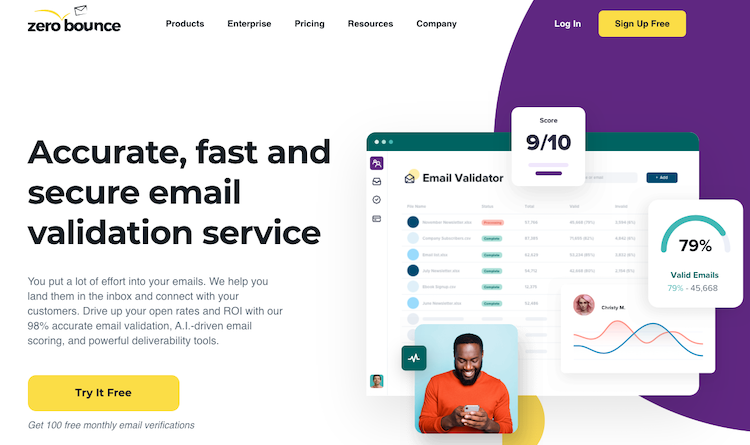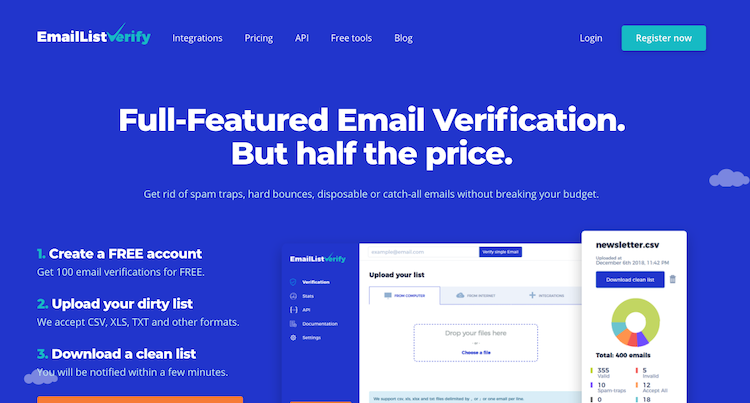If you own a business, you’re well aware of the value of having a good email list.
It lets you connect with potential and existing customers, and it can help you drive a significant amount of traffic to your website. It also allows you to market to individuals who have already expressed an interest in your goods or services.
That being said, to maximize your efforts, it’s crucial to keep this list updated. But why is this so important? And what can you do to keep your list as accurate as possible?
What Is Email Scrubbing?
Email scrubbing refers to the practice of eliminating from your email list all of the addresses belonging to contacts who are non-responsive or who no longer use that email as a point of contact.
The reason why you want to do this regularly is because if you exclusively send communications to people who want to hear from you, you’ll increase your open and click-through rates — in turn improving the quality of your leads and ultimately resulting in a higher conversion rate.
Another equally important reason is that if you send marketing emails to too many fake or closed accounts, these will bounce back to you as undeliverable and increase the risk that you’ll be flagged as a spammer. As a result your emails could end up in most recipients’ junk mail box, unseen.
Warning Signs It’s Time to Clean Up Your Email List
Ok. So only sending communications to people who want to receive them makes a lot of sense. But how do you know it’s time to scrub your email list in the first place?
Keep an eye out for these indicators:
You’ve Noticed a Drop in Open and Click-Through Rates.
When you check your marketing analytics, you’ll be able to see both the open and click-through rates of your marketing emails. If you notice a pattern of declining engagement, it’s time to trim those contacts off your email list.
Otherwise, you’re wasting time and money marketing to people who aren’t interested in hearing from you. On average, you want about a 20 percent open rate, although this may vary depending on your industry.
Your List of Unsubscribers Is Increasing.
This could be because you email them too often, the content is irrelevant to them, or they signed up initially only to get a discount code for a one-time purchase. No matter the reason, don’t take it personally.
However, take this as an opportunity to find out what you can do to keep your audience interested. Take some time to do research — monitor social media groups, discussion forums, or straight out request some feedback.
You’ve Received Too Many Complaints From Subscribers.
Your analytics tools also let you know the number of subscribers who have reported your emails as spam. This could happen for different reasons — maybe they don’t remember signing up for your email list, or maybe they think you send out too many emails.
Regardless, the reason this is a problem is because if too many people using the same server (such as Hotmail, Gmail, Outlook, etc.) report you, the email provider will start sending your communications to other contacts directly to their spam folders.
Your Emails Have a High Bounce Rate.
Your email bounce rate refers to the number of communications that weren’t received by your intended recipient. This could happen because the email address is misspelled, the email is too large, the recipient’s inbox is full, their account has been deleted, or if the recipient has blocked you.
And just as when people report you as spam, a high bounce rate will increase the risk of all your communications ending up in other people’s spam folders.
How Often Should You Scrub Your Email List?
Generally, if an email subscriber has been unengaged for the past six months or so, it’s time to remove them from your email list. Therefore, twice a year is a good timeframe to schedule your email scrubbing.
However, if you notice any of the above listed signs more often, you could benefit from doing so quarterly.
How to Scrub Your Email List
Scrubbing your email list requires taking several steps.
1. Segment Your Contacts Between Active and Inactive.
Anyone who hasn’t engaged with your emails in the past few months is not interested in your marketing efforts. Most software platforms and CRM programs allow you to segment contacts based on desired characteristics.
2. Check for Hard and Soft Bounces.
Soft bounces refer to emails that were undeliverable due to temporary issues, such as a full inbox, the communication was too large, or the server was down.
On the other hand, hard bounces refer to emails that were undelivered due to the sender being blocked or an email address not existing anymore. You only want to eliminate the latter from your email list.
3. Remove Unsubscribers From Your Contacts.
Make it easy for contacts to unsubscribe from your email list. No logins, no confirmation requests.
However, include either a short, multiple-choice exit survey or a comment box for them to state their reason. You can use this information later on to retain future contacts.
4. Run Inactive Emails Through a Scrubbing Software.
There are several email list scrubbing softwares (see below) that will filter out misspelled and fake email addresses. You will then be left with a list of valid email addresses to whom you can send a re-engagement campaign.
5. Try to Re-Engage Inactive Contacts.
Do some market research to identify ways to incentivize former customers to re-engage with you — such as offering special deals, a discount code, or product recommendations that are specifically relevant to them.
10 of the Best Email List Scrubbing Software
1. ZeroBounce

ZeroBounce lets you see bounced emails, open rates, click-through rates, and emails reported as spam in real time. Its application programming interface (API) also scans every email address entered by customers to weed out fake email addresses — and thus ensuring more accurate metrics.
2. ListWise
ListWise removes duplicate email addresses and corrects obvious typos to reduce bounce rates. This reduces the likelihood of having your email servers being blacklisted (aka being flagged as spam) for sending out too many communications to non-existent email addresses.
3. Hunter
Hunter’s Email Verifier allows you to upload your email list file to separate real from fake email addresses. And if you’re just starting to build an email list and don’t have too many contacts, you can get 50 free verifications a month.
4. ReachMail
ReachMail offers customized solutions depending on the size of your business and your email volume, and it offers multiple brand support. They also provide easy marketing services for non-professionals that includes a drag and drop message builder.
5. EmailListVerify

EmailListVerify catches bad emails before they end up in your database, integrates well with a long list of email marketing platforms, and offers flexible pricing options, often at lower rates than other companies, depending on the size of your database.
6. NeverBounce
NeverBounce provides a proprietary email cleaning process that checks each email address from major providers anywhere in the world. It then provides easy-to-understand metrics that are simple to segment and download without having to transfer to an Excel sheet or other type of software.
7. DataValidation
DataValidation has a user-friendly interface that allows you to create an account, upload your email list (or sync your email account contacts), and get a free report. They guarantee a 99 percent deliverability rate, are in compliance with GDPR, and offer 24/7 customer support.
8. Bounceless
In addition to eliminating fake and inactive email addresses, Bounceless also scrubs your email list from contacts matching a complainers database. They also offer free credits to potential customers to try out their service before committing to it.
9. Pabbly
Pabbly is a sales and marketing platform that offers multiple tools — form builders, subscription billing, email marketing, and email scrubbing. While their email verification process is slower (24 hrs vs. the typical minutes of other platforms), they claim to provide the most accurate results.
10. QuickEmailVerification
QuickEmailVerification provides the same services as other softwares. However, they also offer a free tier for businesses with smaller email lists, making it ideal for startups. They also offer volume discounts for businesses with large lists and extensive campaigns.
Keep Email Data Accurate for Continued Results
By maintaining accurate customer data in your CRM, you’re able to maximize all your marketing and sales efforts. Clean data sets you up for continued success in your email marketing and lead nurturing so you can hit your business goals.
Digital & Social Articles on Business 2 Community
(181)
Report Post




